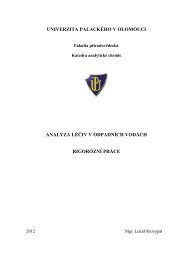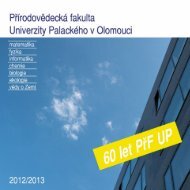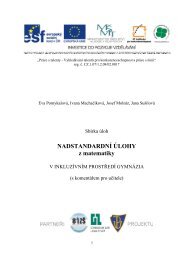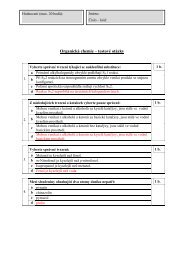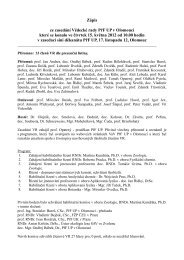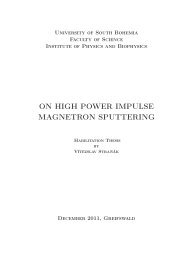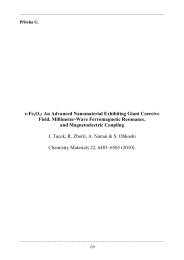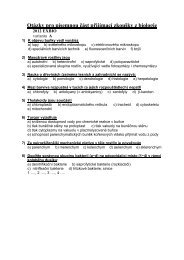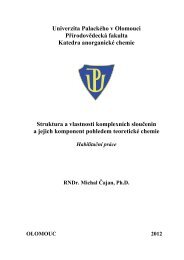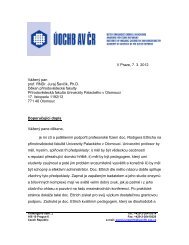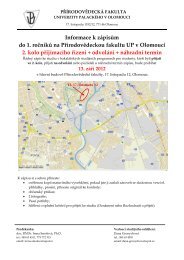A comparative structural analysis of direct and indirect shoot ...
A comparative structural analysis of direct and indirect shoot ...
A comparative structural analysis of direct and indirect shoot ...
Create successful ePaper yourself
Turn your PDF publications into a flip-book with our unique Google optimized e-Paper software.
Aluminium sensitivity <strong>of</strong> root cells related to aluminium internalization 4203<br />
Root growth <strong>and</strong> detection <strong>of</strong> aluminium<br />
Effects <strong>of</strong> aluminium on root growth were observed on seedlings<br />
which, 2 d after germination (DAG), were transferred to Petri dishes<br />
containing agar-solidified nutrient medium with different aluminium<br />
concentrations (0, 10, 50, 100, 200, <strong>and</strong> 300 lM total concentration<br />
<strong>of</strong> Al in the form <strong>of</strong> AlCl 3 .6H 2 O). Root elongation was measured<br />
every day during a 7-d period. After 7 d <strong>of</strong> cultivation, aluminium<br />
was detected by staining whole roots with haematoxylin (Polle<br />
et al., 1978) or morin (Vitorello <strong>and</strong> Haug, 1997). Roots stained with<br />
haematoxylin were observed in bright field <strong>and</strong> morin fluorescence<br />
was visualized by an Olympus BX51 microscope (Olympus, Japan)<br />
equipped with BP 470–490 excitation filter, BA 515 IF barrier filter<br />
<strong>and</strong> a DM 505 dichroic mirror.<br />
Electrophysiology<br />
Measurements <strong>of</strong> the plasma membrane electrical potential difference<br />
(E m ) were carried out at 24 °C in root cells <strong>of</strong> intact Arabidopsis seedlings,<br />
2 DAG, by the st<strong>and</strong>ard microelectrode technique as described<br />
by Pavlovkin et al. (1993). The perfusion solution contained 0.1 mM<br />
KCl, 1 mM Ca(NO 3 ) 2 , 1 mM NaH 2 PO 4 , 0.5 mM MgSO 4 ; pH was<br />
adjusted to 4.5. Diffusion potential (E D ) was determined by application<br />
<strong>of</strong> inhibitors (1 mM NaCN+1 mM SHAM) dissolved in perfusion<br />
solution. The influence <strong>of</strong> morin on E m was measured upon<br />
adding 100 lM morin to the perfusion solution. Effects <strong>of</strong> aluminium<br />
on E m were monitored during continual exchange <strong>of</strong> the perfusion<br />
solution by the experimental solution (50 lM AlCl 3 ) in perfusion<br />
solution, perfusion speed 5 ml min 1 ). After 5 min or 30 min <strong>of</strong> aluminium<br />
exposure the experimental solution was washed out with<br />
perfusion solution. Changes <strong>of</strong> E m induced by aluminium were<br />
measured continuously during the whole experiment. Insertion <strong>of</strong><br />
the microelectrode into the cortical cells <strong>of</strong> the distal portion <strong>of</strong> the<br />
transition zone, located 150–300 lm behind the root tip, <strong>and</strong> <strong>of</strong> the<br />
proximal portion <strong>of</strong> the transition zone, located 300–400 lm behind<br />
the root tip (Verbelen et al., 2006), was performed under microscopic<br />
control. Measurements were evaluated separately for each zone.<br />
Live microscopy <strong>of</strong> aluminium internalization into the cells<br />
Arabidopsis seedlings 2 DAG were transferred to microscopic slides<br />
modified to micro-chambers by coverslips (Ovečka et al., 2005).<br />
The chambers were filled with liquid nutrient medium <strong>of</strong> the same<br />
composition as used for cultivation in Petri dishes, but without agar<br />
<strong>and</strong> placed into sterile glass cuvettes containing the same nutrient<br />
medium (pH 4.5). The seedlings were grown in a vertical position<br />
under light in the growth chamber. During a 12-h period the seedlings<br />
resumed stable root growth. Subsequently the micro-chambers<br />
were gently perfused with the aluminium-containing medium<br />
(50 lM AlCl 3 in nutrient solution, pH 4.5, perfusion speed 10 ll<br />
min 1 ). After a 30 min pulse treatment, aluminium was washed out<br />
<strong>and</strong> the roots <strong>of</strong> the Arabidopsis seedlings were stained with 100<br />
lM morin for 20 min, using the same perfusion technique <strong>and</strong> then<br />
washed with the nutrient solution. After this exchange, internalization<br />
experiments were performed in the micro-chambers <strong>direct</strong>ly on the<br />
microscope stage during 3 h. For labelling endosomes <strong>and</strong> tonoplast,<br />
the styryl dye FM4-64 (N-(3-triethylammoniumpropyl)-4-(8-(4-<br />
(diethylamino) phenyl)hexatrienyl)pyridinium dibromide) was used<br />
at a final concentration <strong>of</strong> 4 lM in nutrient solution, applied for 5<br />
min prior to the aluminium treatment. Internalization <strong>of</strong> aluminium<br />
wasobservedinlivingrootsinrealtimebyaninvertedmicroscopeLeica<br />
DMIRE2,equippedwith theconfocal laser scanningsystemLeica TCS<br />
SP2 (Leica Microsystems Heidelberg, Germany). Excitation wavelength<br />
for FM4-64 was 514 nm <strong>and</strong> for morin 458 nm. Fluorescence<br />
was observed between 640 nm <strong>and</strong> 700 nm (FM4-64) <strong>and</strong> 480 nm<br />
<strong>and</strong> 510 nm (morin).<br />
FM4-64 internalization <strong>and</strong> BFA-induced compartment<br />
formation<br />
Working solution <strong>of</strong> 5 lM FM4-64 was prepared from the stock solution<br />
(1 mg ml<br />
1 FM4-64 in DMSO). With FM4-64 the plants were<br />
incubated for 10 min <strong>and</strong> the dye was washed out before observation.<br />
Roots labelled for 5 min with the FM 4-64 were pretreated with<br />
BFA applied at a concentration <strong>of</strong> 35 lM for 25 min. The effect <strong>of</strong><br />
aluminium was studied by the application <strong>of</strong> 90 lM AlCl 3 for<br />
90 min before treatment with BFA <strong>and</strong> FM4-64.<br />
NO labelling <strong>and</strong> measurements in control <strong>and</strong><br />
aluminium-treated root cells<br />
Detection <strong>of</strong> nitric oxide (NO) was performed by the specific fluorescent<br />
probe 4,5-diamin<strong>of</strong>luorescein diacetate (DAF-2 DA; Calbiochem,<br />
USA). The roots were incubated with 15 lM DAF-2 DA for<br />
30 min <strong>and</strong> washed before observation. As a negative control, they<br />
were treated with 10 lM <strong>of</strong> the NO-scavenger cPTIO (Lombardo<br />
et al., 2006). Examination was performed with a confocal laser<br />
scanning microscope system using st<strong>and</strong>ard filters <strong>and</strong> collection<br />
modalities for DAF-2 green fluorescence (excitation 495 nm; emission<br />
515 nm). Fluorescence intensity was measured with the open<br />
source s<strong>of</strong>tware Image-J (http://rsb.info.nih.gov/ij/).<br />
Results<br />
Influence <strong>of</strong> aluminium on root elongation <strong>and</strong><br />
morphology<br />
Arabidopsis seedlings cultivated for 7 d on agar plates with<br />
different concentrations <strong>of</strong> AlCl 3 exhibited concentrationdependent<br />
inhibition <strong>of</strong> root growth (Fig. 1). Growth <strong>of</strong><br />
the primary roots was only slightly reduced by 10 lM AlCl 3<br />
(to 95% <strong>of</strong> the control values, not statistically significant<br />
according to t test at P¼0.05). Inhibition <strong>of</strong> root growth<br />
was statistically significant at 50 lM AlCl 3 as compared to<br />
control according to t test at P¼0.01. However, growth <strong>of</strong><br />
the primary roots was reduced only to 89% <strong>of</strong> the control.<br />
The inhibition was more apparent at 100 lM <strong>and</strong> 200 lM<br />
AlCl 3 (59% <strong>and</strong> 45% <strong>of</strong> control growth, respectively, highly<br />
significant at P¼0.001), while root growth was fully inhibited<br />
Fig. 1. Root growth <strong>of</strong> Arabidopsis plants cultivated for 7 d on agar<br />
plates with different concentrations <strong>of</strong> AlCl 3 . Growth <strong>of</strong> the primary roots<br />
is progressively affected by 100 lM <strong>and</strong> 200 lM AlCl 3 while root<br />
elongation is inhibited completely at 300 lM AlCl 3 . Average <strong>of</strong> 20<br />
seedlings per treatment (6SD).




